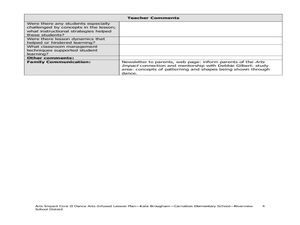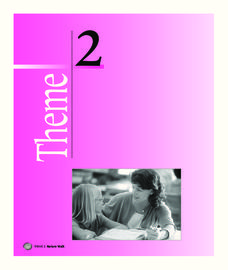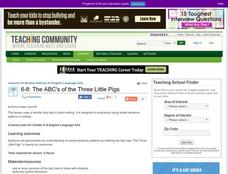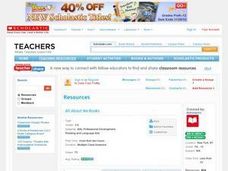K12 Reader
Extending Patterns
2, 4, 6, 8. What comes next? This reading comprehension activity discusses patterns and extending patterns. After reading the short article, kids answer a series of questions to demonstrate their understanding of the passage.
Curated OER
Patterns in Dance and Math
Students analyze how repeated body movements and shapes can represent and extend patterns. In this pattern analysis lesson, students discuss patterns in dance, math, and everyday living. Students demonstrate a dance using a sequence of...
Dick Blick Art Materials
Start with a Circle...
The Golden Ratio. The Divine Proportion. Yup. It's math and art blended into one colorful activity. Young artists combine colored tissue paper circles and parts of circles to create geometric patterns. As a bonus, kids get to figure out...
Curated OER
RHYTHMIC PATTERNS
Students explore rhythmic patterns. They create and perform the rhythms and use Cubase software to perform, record, and play rhythms for use in dictation exercises. They identify and count rhythm patterns
University of Texas
Essential Reading Strategies for the Struggling Reader
Beneficial for beginning readers, struggling readers, and those in need of review, a set of language arts activities is a great addition to any foundational reading unit. Focusing on phonological awareness, fluency, instructional...
Curated OER
Shapes and Patterns in Art and Oceans
First graders draw, cut out, and design their own fish shapes by cutting out shapes and putting them together. In this shapes and patterns worksheet, 1st graders also construct a stamp and print patterns with stamps to repeat a...
Curated OER
Dancing Polygons and Non-Polygons with Patterns
Second graders study movements. In this dance lesson, 2nd graders draw patterns selecting one to represent through movement with their body.
Houghton Mifflin Harcourt
Nature Walk: Extra Support Lessons (Theme 2)
Reinforce concepts such as long vowels, spelling patterns, sound clusters, double-final consonants, and syllables with a nature-themed unit. Through a series of extra support lessons, learners compare and contrast using a...
Curated OER
The ABC's of the Three Little Pigs
Writers use varied sentence patterns. They listen to the story of Cinderella rewritten so that each sentence starts with the next letter of the alphabet. They create their own version of The Three Little Pigs using the same concept.
Curriculum Corner
Be a Speed Reader
Young learners speed their way toward fluent reading with a hands-on consonant digraph activity. Using the numbered grid included in this resource, children roll a die and choose a word corresponding to the number they rolled. They...
K12 Reader
The Note Was in Code!
While it's quite an ode, this short poem uses the long /o/ sound repeatedly in words like code, note, alone, and phone. Kids read the selection and answer three comprehension questions about the text.
Texas Center for Learning Disabilities
Second-Grade Comprehension-Based Intervention
Help your youngsters find meaning in the text they read with this series of five intervention lessons. Offering explicit, step-by-step instructions for walking children through shared readings of leveled books, these...
Curated OER
Rhythmic Pattern and Movement
Learners practice repeating rhythmic patterns in unison. Next, students work in groups to practice an alternate rhythmic pattern to Row, Row, Row Your Boat. They create their own rhythmic patterns for the song.
Curated OER
Pretty Patterns
Students discuss shape and number patterns and play a game practicing completing patterns. Then they rotate through five workstations that reinforce the concept of patterning.
Curated OER
Mouse Mess
Scholars practice rhyming and phonemic awareness using trade books and poetry. They will listen to the book Mouse Mess several times throughout the week, identifying rhyming words, and matching words that begin with the same sound. Then...
Hawaiʻi State Department of Education
Fuzzy Wuzzy
You don't need drums to play percussion; you can use your own body. Second graders use body percussion to make four-beat rhythms and play patterned clapping games. When they are finished they discuss beats, patterns, rhythm, and rhyme.
Houghton Mifflin Harcourt
Family Time: Extra Support Lessons (Theme 5)
Provide extra support with a unit that follows a teach, blend, guided practice, and practice/apply routine to reinforce reading, grammar, vocabulary, and writing skills. Reading and writing lessons include supporting details,...
Houghton Mifflin Harcourt
We Can Do It!: Extra Support Lessons (Theme 10)
Scholars participate in chants, grand discussions, and complete practice pages in a We Can Do It! themed unit. Designed to provide extra support, the assortment of lessons cover topics such as r-controlled vowels, comparatives...
K12 Reader
The Thin Pin Can Spin
Words that end with -in are the focus on this worksheet. Learners read a short poem that includes quite a few -in words to identify and practice and then answer three reading comprehension questions.
K12 Reader
He Must Take the Bus
Build your youngsters' knowledge of the short /u/ sound with a quick exercise. Class members read a brief poem designed to include many words with the short /u/ sound and then answer three reading comprehension questions about...
Hawaiʻi State Department of Education
Ostinato
Quarter notes, eighth notes, and rests; it's time to read rhythmic patterns in music. The class plays ostinatos as they practice identifying rhythmic patterns. They then listen to Mannheim Steamroller as they draw geometric patterns that...
Curated OER
Patterns in Poetry: Part I--Rhythm
Students explore patterns in poetry. In this language arts lesson, students discuss rhythm in poetry. Students read poems and discuss the rhythm of each poem.
Curated OER
All About Me Books
Students examine literature of emergent readers, categorize books into types of literature common for primary readers (wordless, pattern, alphabet, number, rhyme, etc.), and write a book about themselves to give as gifts to their new...
Curated OER
Do You Want to Be My Friend?
Learners participate in a variety of emergent and early-literacy activities based on a "friendship" theme. Learners listen to the book Do You Want to Be My Friend by Eric Carle, then echo read, choral read, and independently read...























